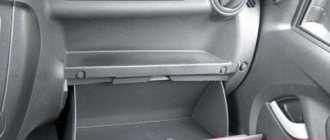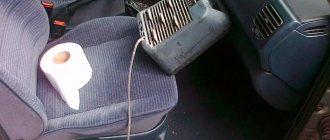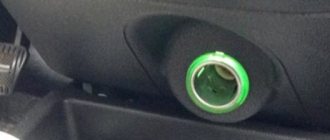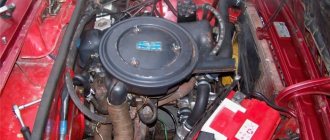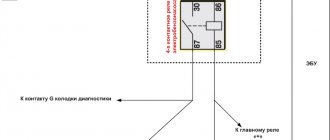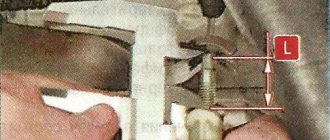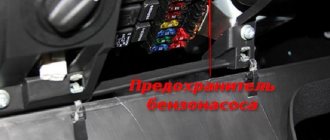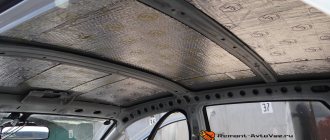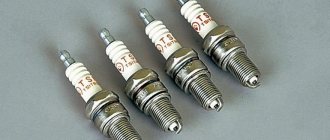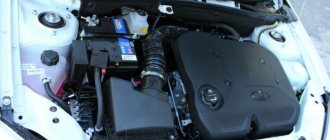Advantages of the car
The lucky ones who own such a car consider its main advantages to be comfort and spaciousness of the interior, high-quality assembly, and attractive design:
I would like to note that the basic equipment of the car is distinguished by its abundance, despite the fact that the prices of the car were determined taking into account the financial capabilities of the middle strata of the population:
To develop the car, the well-known Kalina platform was used as a basis. The modernization process left only the doors unchanged, completely changing the body part. The changes did not bypass the luggage compartment, increasing its volume to five hundred liters:
The car is rightfully considered a reliable vehicle, but sometimes breakdowns occur that are typical for this model range. For this reason, having decided to purchase such a car, it is recommended to clarify how possible it is to repair a Lada Granta yourself.
8 valve engine
On the Lada Granta, the car owner will find engines with 8 valves and 16 valves. They differ from each other in technical characteristics and displacement. Car owners don't like early engines because they are noisy. Some engines with 16 valves often suffer from broken belts and bent valves, which negatively affects owner reviews. But in general, these engines are reliable and last up to 250 thousand kilometers without major repairs.
Let's see what engines were installed on the Lada Granta from 8 valves:
- VAZ 1183-50;
- VAZ 21116;
- VAZ 11183.
For your information! The latest engine of the VAZ 11183 is a primitive four-cylinder engine, which was inherited from its predecessors. The only advantage of the power unit was the reliable gas distribution system. When the belt broke, the valves did not bend.
Now let’s look at the technical characteristics of the first two engines, which represent improved versions of the primitive VAZ 11183 engine.
Engine Specifications
You will see the technical parameters of eight-valve engines in the table below.
| Characteristics 1183-50 | Meaning |
| Cylinders | 4 |
| Type | Row |
| Volume | 1.6 l |
| Valves | 8 |
| Compression | 10 |
| Power | 82 horses |
| Weight | 112 kg |
The fuel consumption of the Lada Granta engine in mixed mode is 7.4 liters. The engine torque is 132 Nm.
This is the simplest engine that is installed on Lada Granta cars: sedan or hatchback. The engine valves are not afraid of belt breakage. Unlike the primitive engine from which this power unit was created, the 1183-50 is distinguished by low-speed torque and environmental friendliness. The manufacturer assigns it the Euro 4 environmental class.
The negative aspects of the engine, according to reviews from car owners, include noise and constant adjustment of thermal valve clearances after a run of 15 thousand kilometers. If the thermostat breaks down, the engine stops heating to the required temperature.
Engine problems include burnt gaskets or valves. Because of this, the motor may operate unstably.
Similar article Design and principle of operation of an internal combustion engine
Despite some disadvantages, for those car owners who want to have a small and unpretentious engine, which also consumes little, this 1183-50 is an ideal solution for installation in a Lada Granta car.
Now let's look at the technical characteristics of another eight-valve engine.
| Value 11186 | Parameter |
| Type | Row |
| Cylinders | 4 |
| Volume in liters | 1,6 |
| Cylinder diameter | 82 mm |
| Piston stroke | 75,6 |
| valves | 8 |
| Torque | 143 |
| Power | 87 hp |
| Fuel supply | Injection method |
| Fuel used | Gasoline AI 95 |
This engine is an improved power unit of the VAZ 21114 model. Among the advantages, one can observe a decrease in engine noise and fuel savings.
The downside is that the pistons are lighter. Because of this, there is no room for recesses in such pistons. Therefore, when the belt breaks, the valves bend.
Device
Both engines have a cast iron cylinder block. The BC head is made of aluminum alloy. What sets them apart from other engines is their unreliable electronics, which can freeze on a frosty day or rainy weather in the summer. And the use of low-quality fuel will certainly lead to burnout of the valves.
The engine design itself looks quite reliable. Eight-valve power units last a long time with annual maintenance and prevent belt breakage.
Engine life
Lada Granta engines run up to 250 thousand kilometers without major repairs. Engine maintenance consists of replacing filter elements every 15 thousand kilometers. The air filter can be changed after 27 thousand km.
Filling and updating of lubricant is done after a run of five or 10 thousand kilometers. Depends on the region where the machine is used. But the coolant can be replaced after 60 thousand kilometers.
Attention! It is not recommended to fill these engines with gasoline with an octane number of AI 92. Since the entire structure of the power unit is very sensitive to high-quality gasoline. This happens because the compression ratio is 10 units. This is the number at which gasoline with octane AI 92 begins to detonate. The latter action, if used continuously, will lead to the death of the motor.
16 valve engine
Now let's talk about 16-valve engines for cars of the domestic manufacturer Lada Granta. These engines are already installed on luxury cars. The power of the power units has been increased, which has affected the reduction in fuel economy.
Some models are used on Lada Granta "Sport" class cars. They are distinguished by high-torque power and rapid development of speed from the start.
Similar article VAZ 11186 engine, do the valves bend on the 8 valve Grant
Technical specifications for Lada Granta
Let's look at the technical characteristics of the 16-valve engine model 21126. They are presented in the table.
| Parameter | Meaning |
| Type | Row |
| Cylinders | 4 |
| valves | 16 |
| Compression | 11 |
| Volume | 1.6 l |
| Cylinder diameter | 82 |
| Piston stroke | 75 |
| Power | 106 hp |
| Petrol | AI 95 |
| Weight | 115 kg |
| Life resource | 250 thousand km |
What distinguishes this engine from the previous two is the presence of DAT and DTV instead of DRMV. In this way, the manufacturer got rid of floating speed at idle speed of the engine. This improved the performance of the power unit from the Lada Grant. It’s true that these engines have become a little more expensive.
A broken timing belt still bends the valve. But this is the price to pay for making the engine lighter and increasing its power.
Now let's look at another engine that was installed on the “Lux” model from Lada Grant. Technical characteristics of this engine 21127.
| Parameter | Meaning |
| Type | L |
| Cylinders | 4 |
| Piston diameter and stroke | Same as previous ones |
| Compression | 11 |
| timing belt | DOHC |
| Torque | 148 Nm |
| Nutrition | Injection |
| Econorms | Euro 4 |
| Weight | 116 kg |
| Life resource | 250 thousand km |
There is another rare engine with 16 valves. It was installed only on “Sport” model cars. The modification of the power unit is designated VAZ 2126-77. It was an upgraded model 2126 engine.
The only difference from other engines was the increase in power after the tachometer crossed the three thousand rpm mark. And its power was 120 horses. Otherwise, it did not differ from the previous engines already described.
Engine design features
The sixteen-valve engine has a cast-iron cylinder block and an aluminum head. Another advantage of these engines was the ability to cover 100 meters in 11 seconds.
The maximum speed that the engine reached was considered to be 172 km/h. This is why car owners fell in love with these engines. Although there were some shortcomings. For example, bending of valves when a belt breaks. This was followed by a major overhaul or a complete change of the power unit.
These engines showed high power, which differed several times from that indicated in the data sheet. However, they often had problems that were also different from the passport problems.
For example, the car owner’s reluctance to take the engine for regular maintenance led to a decrease in the engine’s lifespan. The gasket and pistons on these engines burned out.
The water pump broke down with enviable frequency. Especially residents of the southern regions and those who like to kill cars in difficult operating conditions cannot boast of the absence of overheating.
Similar article Engine temperature indicator and sensor on Lada Grant
Motor life
The service life of sixteen-valve engines exceeds three hundred thousand kilometers if treated with care. The engine life is not lower than the eight-valve one, but does not exceed it, as can be seen from the tables above.
Despite such high engine durability, it has disadvantages that do not suit many car owners. Let's look at these disadvantages.
Lada Granta configurations
Safety
Standard Norma Luxury Inertia seat belts Inertia belts with preload Driver airbag Front passenger airbag Rear seat head restraints ABS+BAS Exterior Bumpers unpainted Bumpers painted in body color Daytime running light in the headlight Stamped wheel rims, 13″ Stamped wheel rims, 14″ Wheels cast wheels, 14″ Wheel caps Radiator grille molding Door moldings External mirrors, painted in body color Door frames black Interior Door trims with decorative inserts Split rear seat Floor sill trim Floor sill seals Glasses container Comfort Steering column with height adjustment Electric power steering Front electric windows Rear electric windows Clear glass Athermal glass Handrails, 3 pcs Cabin air filter Climate system with air conditioning Electric drive and heated exterior mirrors Heated front seats Electric trunk lid lock Electronics Central locking On-board computer Security alarm function Remote control of door locks and trunk lid Audio systemHow to properly dismantle the flywheel
There are several cases in which it is necessary to dismantle the flywheel part:
- Replacing the oil seal with a new one.
- Problems with the ring gear, requiring the surface of the part to be ground, which is necessary for the clutch disc.
Dismantling the flywheel is necessary to repair the oil seals and ring gear.
Further work is carried out in a certain sequence, including:
- Marking the location of the crankshaft with the flywheel.
- Preliminary removal of the gearbox.
- While pulling out the bolts that hold the flywheel together, the device itself should be held in place to prevent it from moving.
- Visual assessment of the teeth for the presence of burrs on their surface, which should not be there.
You can evaluate the surface of the teeth by running your finger over them. Next, you should replace the flywheel with a new one, installing it in place.
Replacement of damaged car parts
Dismantling the flywheel is carried out in several cases: replacing the rear oil seal, breaking the ring gear, to grind the flywheel surface for the clutch driven disc. First you have to remove the gearbox. For ease of further assembly of parts, it is recommended to mark the location of the crankshaft and flywheel.
Pull out the bolts holding the flywheel, holding the device so that it does not move. The condition of the teeth is assessed visually. There should be no burrs on the surface. For ease of assessment, it is recommended to run your finger over the surface. The faulty flywheel is replaced with a new one, the part is installed in place.
The gasket protects the engine from leakage of engine oil and coolant, and it should be replaced with a new one not only if damaged, but also with each intervention in the cylinder block, since it is considered disposable.
It is most convenient to carry out replacement immediately after stopping the car, at which time the pressure is significantly reduced. The piston of the first cylinder is set to the TDC position on the compression stroke. The ground terminal is removed from the battery and the coolant is drained. The air intake filter is removed. The wiring harness block, spark plugs and wires, as well as the oil pressure drop and coolant temperature sensors are disconnected.
After all these simple procedures, you can replace the gasket and connect all the units in the reverse order.
Before replacing the bearing, the gearbox and clutch retainer must be removed. The coupling can then be removed from the structure. On Lada Granta cars, the bearing is mainly combined with a coupling, but one bearing can also be replaced. To do this, you will need to disassemble the coupling itself by squeezing the fixing tabs with any suitable tool.
The bearing must be installed carefully, taking into account the presence of a protruding part, which is intended for the retaining ring. After eliminating the malfunction, you can reassemble the gearbox in reverse order and install everything in its place.
